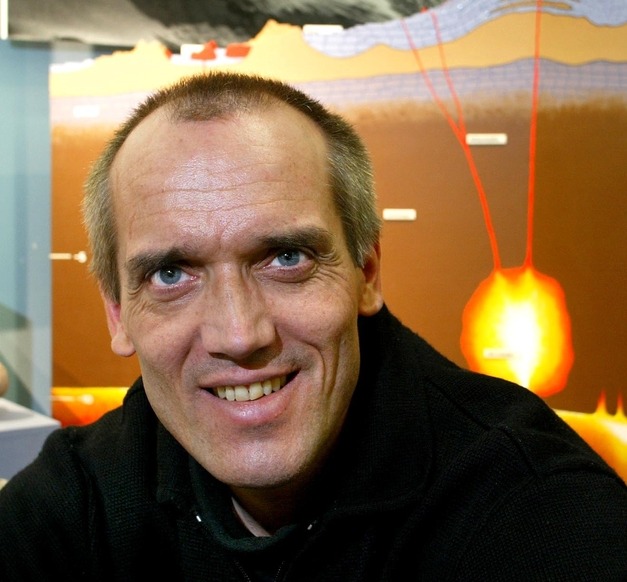When the eruption in Eyjafjallajökull ended last year the mountain was a strange spectacle. The glacier was black as coal and not a white spot was in sight. Steam rose from the glacier. When we arrive on the glacier in July a snowmobile is used for research. Ármann Höskuldsson, Volcanologist at the University of Iceland laughing calls it an ashmobile! Hiking over the glacier with him and Magnús Tumi Guðmundsson, Professor at the Faculty of Earth Sciences, is like going over a desert and feels underfoot very much like Mýrdalssandur. Höskuldsson is wearing his orange parka, nationally famous along with his passion for volcanic activity.
“My interest in volcanic eruptions is in part sparked by the thought that knowledge of them brings us closer to an understanding of the genesis of the Universe,” says Höskuldsson and disappears into a glacial crevasse where he starts to measure the depth of the ash layer with Þorvaldur Þórðarsson, Professor of Geology at the University of Edinburgh. Their moods, unlike the weather, are sunny.
“This was a substantial eruption,” says Magnús Tumi Guðmundsson, as we gaze down one of the main craters of the volcano. The crater is massive and emits smoke in many places. At its bottom a large lake has formed. Guðmundsson is enraptured by the view for a moment but then adds that the eruption in Surtsey was larger; and also the Gjálp eruption in 1996.
“Eruptions are not considered large until volcanic emissions exceed one cube kilometre,” says Guðmundsson. “Over the last 100 years few eruptions have reached this limit, possibly the eruptions in Surtsey and Katla. The eruption in Eyfjallajökull is the largest ash eruption in Iceland since the eruption of Katla in 1918, explaining the considerable disruption caused by the eruption.”
The reason we are standing on the glacier is the greed of the scientists of the Institute of Earth Sciences for data to evaluate the impact of the eruption and to predict the behaviour of similar eruptions in the future. Scientists have used the best weeks of the summer to measure the amount of volcanic emissions from the volcano in Eyjafjallajökull. Magnús Tumi Guðmundsson and Ármann Höskuldsson have led this project along with geologist Guðrún Larsen. Getting a full picture of the amount of emissions reaching the surface in the eruption is quite a challenge.
“The ash that settled on Icelandic soil is between 120 and 150 million cube metres,” says Guðmundsson.
He says that a lot of ash settled outside Iceland; “Probably half of the emissions settled in the sea south of Iceland and some of the ash reached countries in Northern Europe. The combined amount of emissions therefore substantially exceeds 150 million cubic metres.“
Guðmundsson says that the combined mass, or weight, of the volcanic emissions is estimated to be around 400 million tons. “Around 250 million cubic metres of ice melted in the eruption. This is more than double the amount that melted in the last eruption in Grímsvötn, but only a fraction of what melted in Gjálp, where around four cubic kilometres melted. The melting of ice is thus not what makes this eruption unique; but how fine-grained the ash was and how much of it was emitted,” says Guðmundsson.



